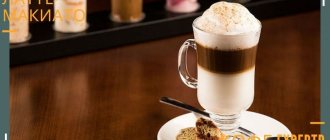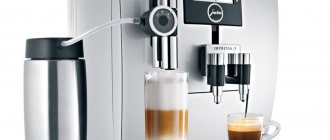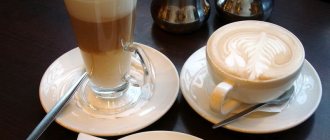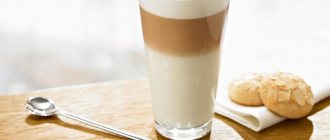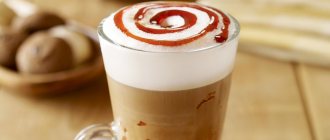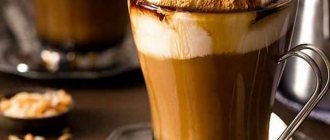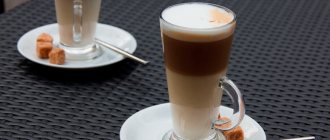Many modern people find it difficult to imagine their life without coffee, but few are interested in what the latte glass is called and how to properly prepare a latte. This coffee drink involves the presence of layers, as guests of cafes and bars are used to, because this multi-layered nature contributes to a beautiful presentation.
This also means that the coffee was prepared incorrectly and the milk separated, which reduces the quality of the drink.
Why is it traditional to serve lattes in glasses?
Latte, translated from Italian, means milk, which was traditionally served in transparent glasses made of glass. Over time, bartenders began to experiment by making cocktails. They added coffee to the milk as a topping. The resulting drink was given a name - latte macchiato. Literally translated this means coffee milk.
They began to use a latte glass as a glass for serving the drink so that the layers were clearly visible. Baristas noted that if you froth milk until foam forms (over time, cappuccino machines began to be used for this purpose), and then pour in espresso coffee in a special way, the last ingredient ends up under the loose light foam, forming a dark layer. Therefore, the tradition of using a latte glass, and not any other glassware, has continued.
Demitas, mug, cup... What's the difference?
Many people have an old favorite mug or cup in which we usually make coffee. But let's think: is this vessel chosen correctly? Each coffee drink has certain characteristics that can be emphasized or, conversely, completely ruined depending on the container used.
Espresso
Classic espresso is the basis for almost all coffee drinks. According to the famous World Barista Competition (WBC), an espresso shot should be served in a 60-90 ml demitase with a handle. When it comes to espresso, mug size is especially important. Small cups in which espresso is served help maintain temperature and the drink is less exposed to air. As you can see, many demitases (espresso mugs) are narrow at the base and widen at the edges. This design is ideal for maintaining the richness of the shot. It is also more convenient to add cream to a mug of this shape.
Cappuccino
Cappuccino is made by mixing equal amounts of espresso and frothed milk.
According to WBC standards, to serve it correctly, you need to use a mug with a handle with a volume of 150-180 ml. To make the drink look more beautiful, the volumes of coffee and mug must match. As with espresso containers, cappuccino containers are narrower at the base and wider at the edges. Cappuccino mugs should always be served with suitable saucers. If you use a mug of this volume, the foam that is on top of the drink will take the correct shape - in the form of a dome. This is also part of the charm and tradition of serving cappuccino.
Latte
Latte should be served in a wide cup-shaped container with a volume of 325-440 ml. The volumes of the vessel and its contents must be equal. In other words, it should be filled to the brim. A wide container is needed to make it easier for baristas to pour steamed milk into espresso, creating latte art.
Coffee mug
A regular, old-fashioned coffee mug should hold 295-470 ml of drink. In addition to espresso, latte and cappuccino, you can add anything to it and prepare coffee in any way you like: pour over, French press, etc.
Serving options
The experiments continued. Over time, alternative options for serving the drink have emerged. Currently, the choice of containers is quite large.
Cup
The latte glass is made of glass. Its volume can range from 150 to 300 milliliters. A special feature of this type of accessory is the presence of a handle. There are two main types of products.
The first type is an ordinary glass, which looks like a glass cup, the second is an accessory that looks like an oversized glass. As a rule, a product with a handle has a smaller volume. And although its height is equal to the standard one, it holds less drink.
Which is better - a glass or a mug?
If, after the appearance of the drink, only a latte glass was used for serving, then over time such accessories began to be replaced. There are several reasons. Firstly, this is the need for maximum mixing of components.
The taste can only be revealed if the composition is uniform. Therefore, a real barista will try to mix the ingredients as much as possible. Accordingly, the aesthetic load of transparent glass accessories is leveled, and there are fewer and fewer people who want to enjoy the appearance of layers at the expense of taste.
The second reason is the ability of the cookware to maintain temperature. Porcelain and ceramic products look much more practical here.
Another important factor: establishment owners often prefer to use universal accessories. For example, a mug made of ceramics is perfect for serving tea, Americano or other drink. In this way, the establishment's costs are reduced.
Despite all the nuances, latte glasses are still quite popular accessories, because taste characteristics are not a limiting factor in terms of the choice of glassware. In addition, the temperature of the drink in any case decreases during consumption. Conclusion: the main trends are dictated by practical considerations and fashion.
How to care
Before use, be sure to first read the instructions for use and care. After all, the material and shape features often require special handling, but usually maintenance is relatively simple:
- Timely cleaning of dishes with an appropriate detergent, either manually or in a washing machine. But if the instructions prohibit the use of very high liquid temperatures, you should not take risks with the dishwasher, since it is usually set to hot processing mode.
- Refusal from abrasives of any kind; in case of severe contamination, it is permissible to rub with baking soda, without zeal. Other types of abrasive substances in chemicals or in the form of a metal sponge or hard rag should be excluded. Otherwise, microscratches will appear that can ruin the appearance of the product and make it visually shabby.
- Do not use chemicals with a strong odor; it affects the aroma of the drink in the glass, and the coffee acquires an unpleasant specific taste. And this is fraught with dissatisfaction of the client or spoiled the mood of the coffee lover.
Timely cleaning of dishes with an appropriate detergent, either manually or in a washing machine.
So, latte dishes have many varieties in shape, color, material and volume. But usually tall transparent types are used to demonstrate the layering of ingredients of different shades, although this affects the taste. So when choosing such utensils, you should decide what is your priority: preparing tasty, smooth, rich coffee or a drink served in layers in a beautiful container.
Features of choosing a glass
Some people prefer to drink the drink using a latte glass, others like heavy glasses or mugs. If you prefer classic solutions, you should pay attention to cups. To make the most correct choice, you need to follow certain simple rules. The criteria are as follows:
- Volume and height;
- Type of material from which the product is made;
- Form.
It is advisable to give preference to a large-volume accessory. 280-300 milliliters is the average serving of latte macchiato. The larger the cup, the more space there is for decent crema, which should be between 4 and 6 millimeters high. In addition, baristas often decorate the top of the drink with chocolate chips.
It is also preferable to use a product made of ceramics, porcelain, or glass. Plastic is worse. At the same time, at the time of purchase, you need to carefully inspect the cup to determine the quality of its coating inside. There should be no chips or cracks.
The most comfortable cup is the one made in the shape of a trapezoid. The drink poured into such a container remains warmer.
A cup of decent quality costs about 600-800 rubles. Products under the brands James Salder (England), Tescoma are popular. Just like a glass latte glass, cups made from the same material are cheaper than ceramic ones. You can purchase an accessory from the same company Tescoma for only 340 rubles.
Cups for coffee and tea
The ideal cup for serving coffee is one that performs several important functions: it will preserve the taste and aroma of coffee due to its optimal shape and low thermal conductivity of the material, and will also be convenient to use and, of course, have a beautiful appearance in order to ensure the aesthetic side of the coffee ceremony. It’s not for nothing that they say “you meet someone by their clothes,” because in the case of coffee this can be paraphrased as “in a beautiful cup, the coffee will seem twice as tasty.” Agree, often a beautiful cup largely determines the attitude towards its contents. By the way, in addition to the usual familiar cups for drinking coffee, coffee pairs, glasses and glasses for coffee, as well as special utensils are also widely used. An unrecognized classic in this matter can be considered white cups with white saucers, which always stand out effectively and stylishly with dark coffee in them!
However, if you prefer creativity in this matter, then today on the market you can find a wide variety of coffee cups in the most interesting and unusual variations: with drawings, relief images, as well as with unusual shapes, which, by the way, are not always convenient to use. Many self-respecting coffee brands offer a wide variety of coffee cups. In addition to prestige, this is also a smart marketing move that allows brands to conquer more segments of the coffee market. However, let's not go into the jungle of marketing discipline, but let's return to our cups.
As mentioned above, the choice of a coffee cup is largely determined by what kind of coffee will be served in a particular cup. So, let's start with a cup that is familiar and familiar to everyone - an espresso cup . As a general rule, an espresso cup should have thick walls and be made of high-quality porcelain and coated with durable enamel. The optimal shape of an espresso cup is elliptical, and the volume of an espresso cup varies from 35-40 to 50-70 ml. Before filling the espresso cup, it must be preheated to ensure the coffee is at the optimal temperature and enhances its aroma.
The next coffee cup is a cappuccino cup , which is similar to an espresso cup, but differs in volume - 120-220 ml. According to coffee lovers, you can also make Americano and espresso in such cups, although there are already cups for them. The cappuccino cup also has thick walls coated with durable enamel.
An Americano cup is also similar to a cappuccino cup, but the volume is also different - 220-230 ml. Among all those listed above, the Americano cup will be the largest in size.
As for coffee cocktails, and there are a lot of them, completely different utensils are needed here - special glasses and glasses for cocktails.
Such dishes should be made of heat-resistant glass, since there are also hot coffee cocktails. As for cold cocktails, before pouring such a cocktail into a glass, it is first cooled in the refrigerator. Finally, I would like to note that a correctly chosen coffee cup will make the coffee ceremony even more pleasant and beautiful, providing aesthetic pleasure in addition to the wonderful and beloved aroma of coffee! Short version of the article
